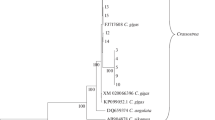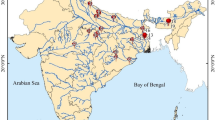Abstract
Nucleotide sequence divergence in a novel major mitochondrial DNA intergenic spacer (IGS) of Pacific oysterCrassostrea gigas was analyzed for 29 cultured individuals within the Goseong population (Korea). A total of 7 variable sites were detected within the IGS, and the relative frequency of nucleotide alteration was determined to be 1.16%. All alterations were due to a single nucleotide substitution, and 5 transitions and 2 transversions were observed. Among 29 specimens, only 8 haplotypes could be identified, and 6 of the haplotypes were unique to particular specimens. Pairwise genetic diversity of all 8 haplotypes was calculated to be 0.412 ± 0.134 from multiple sequence substitutions based on the two-parameter model. The phylogenetic tree obtained for these haplotypes according to the neighbor-joining method illustrated a single cluster of linkages, which comprised 5 haplotypes associated with 23 specimens, while the other 3 haplotypes associated with 6 specimens were scattered. The results indicate that the IGS is higher polymorphic and thus more suitable as a genetic marker for population structure analysis of Pacific oyster than the mtDNA coding regions, such as cytochromec oxidase I and 16S ribosomal RNA genes.
Similar content being viewed by others
References
Aranishi F, Okimoto T, 2004. Genetic relationship between cultured populations of Pacific oyster revealed by RAPD analysis. J Appl Genet 45: 435–443.
Aranishi F, Okimoto T, 2005. Sequence polymorphism in a novel noncoding region of Pacific oyster mito-chondrial DNA. J Appl Genet 46: 201–206.
Chew KK, 1990. Global bivalve shellfish introductions. World Aquaculture 21: 9–22.
Boudry P, Heurtebise S, Collet B, Cornette F, Gerard A, 1998. Differentiation between populations of the Portuguese oyster, Crassostrea angulata (Lamark) and the Pacific oyster, Crassostrea gigas (Thunberg), revealed by mtDNA RFLP analysis. J Exp Mar Biol Ecol 226: 279–291.
Boudry P, Heurtebise S, Lapegue S, 2003. Mitochondrial and nuclear DNA sequence variation of presumed Crassostrea gigas and Crassostrea angulata specimens: a new oyster species in Hong Kong? Aquaculture 228: 15–25.
Bruford MW, Bradley DG, Luikart G, 2003. DNA markers reveal the complexity of livestock domestication. Nat Rev Genet 4: 900–910.
FAO, 1997. Review of the state of world aquaculture. FAO Fisheries Circular 886, FAO, Rome.
Hoelzel AR, 1993. Evolution by DNA turnover in the control region of vertebrate mitochondrial DNA. Curr Opin Genet Dev 3: 891–895.
Imai T, Sakai S, 1961. Study of breeding of Japanese oyster,Crassostrea gigas. Tohoku J Agric Res 12: 125–171.
Kimura M, 1980. A simple method for estimating evolutionary rates of base substitutions through comparative studies of nucleotide sequences. J Mol Evol 16: 111–120.
Okimoto T, 2006. Comparative genetics for putative control regions of mitochondrial DNA in Pacific oyster. Ph.D. Thesis, Nagasaki University, Nagasaki, Japan.
Page RDM, 1996. TREEVIEW: An application to display phylogenetic trees on personal computers. Comput Appl Biosci 12: 357–358.
Park BH, Park MS, Kim BY, Hur SB, Kim SJ, 1989. Culture of the Pacific Oyster (Crassostrea gigas) in the Republic of Korea. FAO, Rome.
Pollock DD, Eisen JA, Doggett NA, Cummings MP, 2000. A case for evolutionary genomics and the comprehensive examination of sequence biodiversity. Mol Biol Evol 17: 1776–1788.
Rana K, Immink A, 2001. Trends in global aquaculture production: 1984–1996. FAO, Rome.
Saitou N, Nei M, 1987. The neighbor-joining method: A new method for reconstructing phylogenetic trees. Mol Biol Evol 4: 406–425.
Sato M, Nagashima K, 2001. Molecular characterization of a mitochondrial DNA segment from the Japanese scallop (Patinopecten yessoensis): demonstration of a region showing sequence polymorphism in the population. Mar Biotechnol 3: 370–379.
Thompson JD, Higgins DG, Gibson TJ, 1994. CLUSTAL W: improving the sensitivity of progressive multiple sequence alignment through sequence weighting, position-specific gap penalties and weight matrix choice. Nucleic Acids Res 22: 4673–4680.
Author information
Authors and Affiliations
Corresponding author
Rights and permissions
About this article
Cite this article
Aranishi, F. A novel mitochondrial intergenic spacer reflecting population structure of Pacific oyster. J Appl Genet 47, 119–123 (2006). https://doi.org/10.1007/BF03194610
Received:
Accepted:
Issue Date:
DOI: https://doi.org/10.1007/BF03194610




